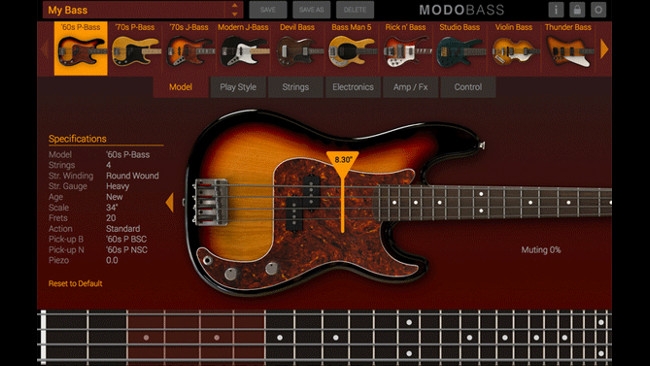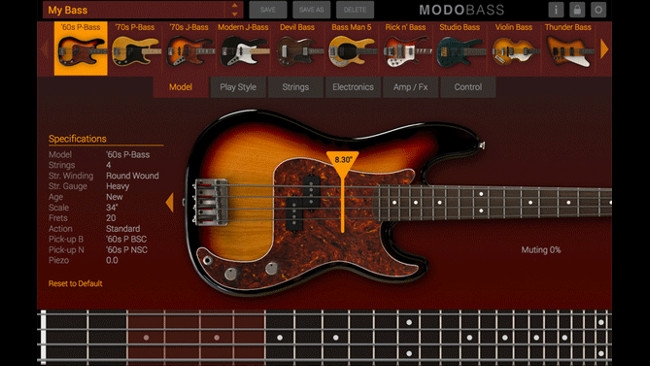
 Screenshot of MODO BASS from IK Multimedia
Screenshot of MODO BASS from IK Multimedia
Here's a peek at the first ever virtual electric bass that's been physically modelled to behave as it would in the real world.
There are several ways to make an electronic instrument sound like a real acoustic one. You can synthesise it, which means you use a bunch of oscillators interacting with each other, with filters and amplifiers to emulate the instrument as closely as possible. You can sample an original instrument. And you can physically model it.
The first of these can get close in the right circumstances: subtractive synthesis can do strings really well. Sampling is obviously fantastic, but depends on huge libraries of samples if the instrument is going to be playable. Physical modelling is something altogether different.
The CGI of audio
The best way to think of it is as being analogous to CGI models. These are computer generated virtual structures that simulate as closely as the technology will allow the original real world object (or not real world at all, in the case of science fiction). You can add realistic interactions to these models. In other words, you can also model how they react to external stimuli and their environment.
In the world of audio, computer modelling is just as valid. It’s possible make a physical model of an instrument to emulate not its appearance, but its sound. For example, a model of a clarinet would give it a single reed and a 12 note overblow (the note you play on a clarinet jumps up by twelve notes if you blow too hard, not the 8 note, i.e. one octave, that’s more common with other instruments - a saxophone, for example).
The shape of the inside of the instrument, as well as any other physical attributes, will be included in the model and will affect the sound according to the way it is played.
IK Multimedia has just announced a new physically modelled bass guitar. From the company's press release, it sounds extremely adaptable and versatile. It takes into account all kinds of input and we would expect it to render a very realistic sound that changes dynamically with the playing style.
Here’s IK Multimedia's own description of how it works:
IK Multimedia, the pioneer in analog effects modelling, is pleased to announce MODO BASS®, a breakthrough physical modelling technology that brings a completely new level of realism and playability to the world of virtual bass instruments. MODO BASS is a completely customisable physically modelled virtual bass that recreates the electric bass and how it's played - from the physical instrument and everything that makes it sound the way it does, to the human technique of how the instrument is played and its sonic performance, to the entire sound signal chain - no detail is left out.
This pioneering approach to virtual instrument technology recreates the dynamic interaction between the player, the bass, effects chain and amplifier that until now has never been realized nor recreated with traditional virtual instruments. This intense evaluation and modelling process gives players and producers access to a limitless universe of bass sound, an unmatched level of playability and the most realistic, lifelike sounding dynamic performance. No other bass virtual instrument can even come close to offering what MODO BASS provides.
Eight years in the making and developed in collaboration with one of Europe's oldest universities, MODO BASS utilizes a breakthrough technology to breathe life into bass tracks. Unlike traditional sample-based virtual instruments, MODO BASS utilizes modal synthesis technology and an ultra-optimized sound engine to model each string as a nonlinear resonator where the string's acoustic behaviour is determined by its physical parameters as well as by the interaction of the string with fretboard, body and pick-ups of the instrument. The action of the player is then modelled as a nonlinear physical interaction with certain areas on the string surface. Then using IK's cutting edge analog modelling expertise, the amp and effects rig of the electric bass is added to the sound chain.
All of this gives MODO BASS the ability to create sound in real time based on the construction and components of the bass combined with the player technique, finesse and the ever-changing dynamic interactions between the two. In short, MODO BASS brings - for the first time - ever-changing, hyper-realistic, living-breathing bass sound and performance to the world of virtual instruments. And since it doesn't use samples, MODO BASS has an extremely small memory footprint.
Virtually every electric bass sound
Continuing IK Multimedia's description of MODO BASS:
The foundation of MODO BASS is a collection of 12 physically modelled iconic electric basses that span the history of bass sound in recorded music - more bass models than available in most other virtual instruments. Bass models include "60s P-Bass" based on an Alder body 60s era Fender Precision Bass®, "70's P-Bass" based on an Ash body Fender Precision Bass®, "70's J-Bass" based on an Alder body Fender Jazz Bass®; "Modern J-Bass" based on an Ash body Fender Jazz Bass®, "Devil Bass" based on Gibson® EB-0; "Bass Man 5" based on Music Man® StingRay 5-string; "Rick n' Bass" based on Rickenbacker® 4003; "Studio Bass" based on Yamaha® RB5; "Violin Bass" based on a Hofner® Violin Bass, "Thunder Bass" based on a Gibson® Thunderbird, "Japan Bass" based on an Ibanez® Soundgear, and "Flame Bass" based on Warwick® Streamer.
Every detail of each bass has been meticulously analysed and modelled to capture the true sonic character of the original basses - the shape and type, the wood used for the body and neck construction, the hardware components like bridge and tuners, the original onboard electronics and controls - every aspect and detail has been modelled and recreated to provide the highest degree of sonic authenticity of the original. But the sounds available with MODO BASS extend far beyond the 12 modelled basses; with the available customisation features, users can craft virtually every electric bass sound imaginable.
Tags: Audio


Comments